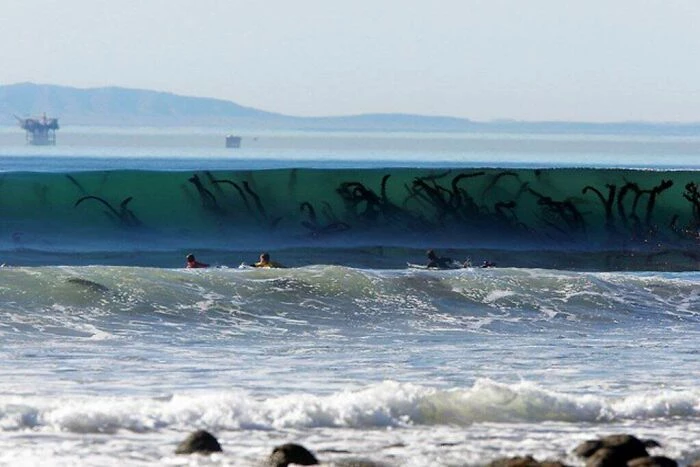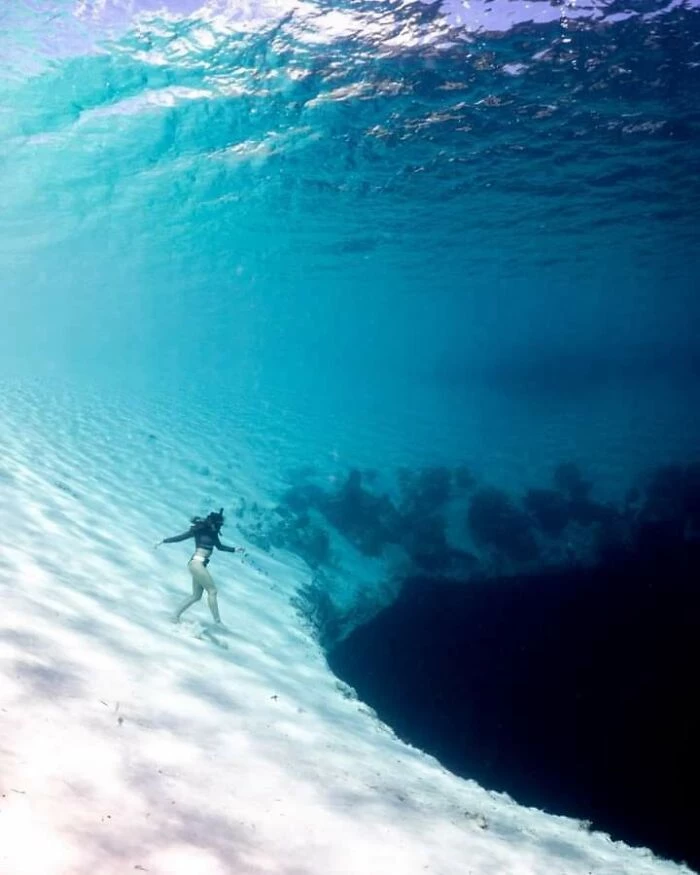Overcome Thalassophobia Without Medication For Great Beach Swimming Experience
Today, we will dive into the transformative journey of conquering thalassophobia—the fear of deep water—and unlock the secret to an exhilarating beach swimming experience. In this guide, we'll navigate the waves of anxiety without the need for medication, offering a sea of practical tips and techniques.
After this guide, maybe we will embrace the freedom of open waters that transcends fear, ensuring your next beach day is filled with joy, not fear. Let the soothing sounds of the ocean be your guide to overcoming thalassophobia for a truly refreshing experience.
What Is Thalassophobia?
 Source: Google
Source: Google
Thalassophobia is the persistent and intense fear of large bodies of water, particularly the vastness, depth, and emptiness of the sea.
Individuals with thalassophobia may experience anxiety, panic attacks, or extreme discomfort when confronted with deep bodies of water, such as oceans, lakes, or large rivers.
The fear is often related to the perceived unpredictability and unknown aspects of the deep sea. It can range from a general unease to a paralyzing fear, impacting a person's ability to enjoy activities like swimming or participating in water-related events.
How Common Is Thalassophobia
 Source: Google
Source: Google
According to estimates, about 7-9% of the global population experiences specific phobias at some point in their lives. As for thalassophobia, its prevalence may vary among individuals and across cultures.
Some people may have a mild aversion to deep water, while others may experience more severe symptoms.
How Do I Know If I Have Thalassophobia?
If the ocean or any big body of water sends shivers down your spine, you might be in the thalassophobia club. Picture this: the water's calm, like a zen mirror, yet you're feeling the fear vibes. It's like the ocean's got a secret language only your anxiety understands.
Thalassophobia shares symptoms with other specific phobias, such as claustrophobia. It can include both a fear of drowning in deep water and a fear of what might be lurking in deep water.
Symptoms of thalassophobia and other specific phobias can be both physical and emotional.
 Source: Google
Source: Google
Physical Symptoms of Thalassophobia
- Shaking and trembling
- Sweating
- Dry mouth
Increased heart rate or heart palpitations
- Difficulty breathing, including hyperventilating
- Chest pain
- Feeling faint, dizzy, or weak
- Nausea or stomach cramps
- Chills
- Numbness or tingling in the hands
- Thalassophobia can trigger a panic attack, which may induce symptoms such as:
- Sudden onset of anxiety or fear
- Fear of losing control or dying
- Feelings of detachment
- Anticipatory anxiety (experiencing anxiety when you know you will be near a large body of water)
How To Overcome Thalassophobia Without Medication
 Source: Google
Source: Google
Conquering a fear of deep water might seem like a daunting challenge, but with patience and determination, you can train yourself to feel more comfortable.
Combat your fear by mentally preparing yourself, engaging in gradual exercises, or seeking professional guidance to gradually acclimate to the deep end.
Remember, progress takes time, and each small step forward brings you closer to overcoming your fear.
 Source: Google
Source: Google
Part 1: Mentally Preparing Yourself
Acknowledge your fearIt's common for people with aquaphobia to feel embarrassed or ashamed about their fear, often going to great lengths to avoid confronting it.
However, the initial step towards overcoming this phobia is accepting it. Embracing the fact that you have aquaphobia sets the stage for addressing and gradually conquering your fear.
Put your fear into perspective
Fear of deep water is a widespread experience that affects millions of people. Everyone has their own comfort level with water, and it's normal not to feel at ease in deep-water situations.
There's no need to be ashamed of it. Studies show that more than half of American adults share this fear of deep water, making it a common concern.
Identify the origin of your fear
If you're gearing up to confront your fear of water, take a moment to reflect on when you first noticed this fear.
Was there a specific event or person that triggered your phobia? Identifying the root cause of your fear might provide insights that can help you better understand and cope with your anxiety.
 Source: Google
Source: Google
Part 2: Facing The Water
Pick a safe, comfortable body of waterSelect a safe and comfortable body of water to confront your fear. If water makes you uneasy, start in a controlled environment, like a pool, where factors such as temperature, depth, and flow are regulated.
- You want to limit any other discomforts you might feel, like freezing water or lots of spectators, so find a body of water that is comfortable in every other way besides your fear of the deeps.
- Opt for clear water to ease anxiety, as it allows you to see the bottom.
- A cake bay or lake outdoors could be suitable, but it's ideal to pick a spot with a gradual descent, allowing you to ease into the water slowly.
Have someone you trust present.
When facing your fear of the deep end, it helps to have a trustworthy companion with you.
If embarrassment is a concern, consider enlisting the help of a trained professional, such as a swimming instructor or lifeguard, who understands water safety and is experienced in assisting individuals in overcoming water-related fears.
Alternatively, choose a supportive person in your life who won't pressure or ridicule you during this process. Opt for someone with swimming experience and comfort in the water to provide reassurance and guidance as you work to overcome your fear.
 Source: Google
Source: Google
Wade into the water, stopping when you feel fearful.
Confronting your fear of the deep end involves taking gradual steps. Start by wading into the water as far as you feel comfortable, paying attention to the point where nervousness kicks in. If you start to feel uneasy, pause and take a few deep breaths.
Allow yourself time to become familiar with that depth before turning back towards shallower waters. Taking it one step at a time can help build your confidence and ease your apprehension about the deep end.
Push yourself to go a bit deeper, one step at a time.
Take your time to gradually increase your comfort level in deeper water. Start by walking in slow circles through the shallows, expanding the circumference of your path as you go slightly deeper each time.
The key is to progress at a pace that feels right for you. Some may make quick strides, while others might prefer a more gradual approach over an extended period.
Always remember that you're in control of the process, and it's okay to stop if you start feeling overwhelmed. Try to focus on the pleasurable sensation of the water against your skin, letting it distract you from any lingering fears.
 Source: Google
Source: Google
Be mindful of your breathing
If you concentrate on keeping your breath slow and regular, it can help mitigate panic or other bodily responses to the fear that you’re facing. As you walk in circles, focus on breathing in deeply to the count of five and exhaling slowly to the count of seven.
 Source: Google
Source: Google
Part 3: Extending Your Comfort Zone
Put your head underwaterTaking the plunge into deep water can be challenging for those with aquaphobia. To ease into it, start by acclimating yourself to having your head submerged in a controlled, shallow environment.
Wade in until you're about waist-deep, making it easy to bend over and reach the water. Begin by splashing water on your face, allowing it to adjust to the temperature.
As you get comfortable, crouch down with your mouth closed, submerging your chin and lips. Practice breathing through your nose while submerged.
Once confident, hold your breath and submerge your nostrils briefly. Finally, fully submerge your head, holding your breath for a few seconds. Gradual steps can help you build confidence and overcome your fear.
 Source: Google
Source: Google
Blow bubbles
This exercise is designed to help you feel more at ease when exhaling underwater without inhaling water through your mouth or nose. It's a useful step toward feeling comfortable in deeper water and learning how to safely interact with it.
Begin by standing in waist-deep water, crouching down so your mouth is just above the water's surface. Inhale through your nose and exhale through your mouth, observing the ripples in the water.
Gradually submerge your mouth while keeping your nose above water, blowing bubbles by exhaling slowly through your lips. Repeat the process, this time submerging your nose and exhaling through your nostrils.
Finally, take a deep breath, fully submerge your head, and blow bubbles simultaneously from your nose and mouth. These steps help build confidence and control in the water.
 Source: Google
Source: Google
Try floating
Understanding that water has buoyancy and can support your body can significantly alleviate anxieties about being in deep water. If you're new to floating, it's beneficial to have a partner assist you in a safe and supportive environment.
To practice floating, have your partner gently pull your arms through the water while you lie flat and relax your entire body. Alternatively, your partner can support you in a stationary position by placing their arms under your back while you lie on your back in the water.
Once you become comfortable with assisted floating, challenge yourself to float on your own, gradually building confidence in the water.
Swim where you can hang onto somethingWhen you’re first testing yourself in deep water where you can’t touch the bottom, be sure to stick to an area where you can easily reach out and grab something to steady yourself.
 Source: Google
Source: Google
Part 4: Seeking Professional Help
If facing your fear of deep water seems too overwhelming, don't hesitate to reach out for support. Contact your healthcare provider, and they can refer you to a mental health professional like a psychologist, therapist, or anxiety counselor.
These experts specialize in helping people overcome fears and anxieties by providing guidance on managing thoughts, feelings, and reactions.
With their support, you can work on building the skills and self-control needed to conquer your fear of deep water. Remember, seeking help is a brave step toward a more confident and comfortable you
Conclusion
In conclusion, from understanding the common symptoms of thalassophobia to practical tips on overcoming this fear, we've curated a set of techniques to help you enjoy the waters without medication.
Whether it's acknowledging your fear, gradually facing the water, or extending your comfort zone, each step is a stride toward overcoming thalassophobia. Dive into the soothing sounds of the ocean and embrace the joy of beach days without fear, making your next seaside experience truly refreshing.